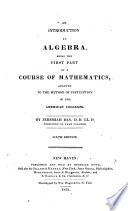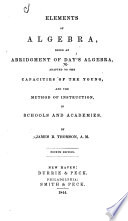 | Jeremiah Day - Algebra - 1814 - 304 pages
...the. two terms ; + the square of the latt term. And the square of a residual quantity, is equal to the square of the first term, — twice the product of the two terms, + the square .of the last term. .LCI ilia, -|- uit; ai|uaic .ui iiit jouai i^ixii. Ex. 1. The square... | |
 | Jeremiah Day - Algebra - 1827 - 352 pages
...following proposition.* THE SQUARE OF A BINOMIAL, THE TERMS OF WHICH ARE BOTH POSITIVE, IS EQUAL TO THE SQUARE OF THE FIRST TERM, + TWICE THE PRODUCT OF THE TWO TERMS ; + THE SQUARE OF THE LAST TERM. And the square of a residual quantity, is equal to the square of the... | |
 | Jeremiah Day - Algebra - 1831 - 358 pages
...-f-THE SQUARE OF THE LAST TERM. • • • And the square of a residual quantity, is equal to TOG square of the first term, - twice the product of the two terms, + the square of the last term. Ex. 1. The square of 2a+b, is 4a 2 +4a6+6 3 . 2. The square of A+1,... | |
 | Frederick Emerson - Arithmetic - 1834 - 300 pages
...divisor, making 80-\-5 = 85, and multiplied the sum by 5, the last figure in the root, and thus obtained twice the product of the two terms, and the square of the last term; because", 80 is twice the first term of the root, and being multiplied by 5, which is the... | |
 | Silas Totten - Algebra - 1836 - 332 pages
...3a)2 = 4a464 — 12a362 + 9az. We hence conclude, that the square of any binomial is found by taking the square of the first term, twice the product of the two terms, and the square of the last term, and connecting them by their proper signs. If the second term of the binomial be negative,... | |
 | Mathematics - 1836 - 488 pages
...product of their powers. The square of a binominal, the terms of which are both positive, is equal to the square of the first term, + twice the product of the two terms, + the square of the last term. When the root is positive all its powers are positive also ; but when... | |
 | Silas Totten - Algebra - 1836 - 360 pages
...inspecting this result, it will be seen that the square of a polynomial of three terms is composed of the square of the first term, twice the product of the first by the second, the square of the second, twice the product of the first by the third, twice the... | |
 | Frederick Emerson - 1840 - 302 pages
...divisoi, making 80 -(-5 = 85, and multiplied the sum by 5, the last figure in the root, and thus obtained twice the product of the two terms, and the square of the last term; because, 80 is twice the first term of the root, and being multiplied by 5, which is the... | |
 | James Bates Thomson - Algebra - 1844 - 272 pages
...the two terms, -|- the square of the last term. (2.) The square of a RESIDUAL quantity, is equal to the square of the first term, — twice the product of the two terms, -|- the square of the last term. 39. Find the square of Za-\-b. 40. Find the square of A+l. 41. Find... | |
 | Davis Wasgatt Clark - 1844 - 394 pages
...Theorem. 202. The square of a polynomial expressing the difference between two numbers, is equal to the square of the first term — twice the product of the two terms + the square of t'he last term. Let d represent the difference, and a— b the polynomial : Then ........ | |
| |